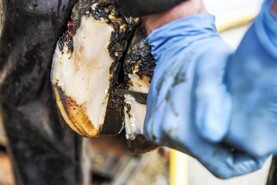Grass management
Growth rates have dropped significantly in recent weeks with the dip in temperature, while swards are under greater pressure and grass is heading out faster as a result.
It is a critical timeframe for a high percentage of lambs entering late lactation and becoming more reliant on grass intake and herbage quality to drive performance.
As such, tweaks may need to be made to current management to sustain high levels of performance.
The ideal scenario at this stage of the year is for animals to be entering swards at a pre-grazing height of 7cm to 9cm (1,250kg-1,500kg DM/ha) and exiting at a post-grazing sward height of 4.5cm. The reality is that this will not be possible in some circumstances.
This is due to an accumulation of lower-quality herbage at the base of the sward. In such cases there will be no option but to remove animals at a greater post-grazing sward height and address quality by creep grazing lambs ahead of ewes or using lower-priority animals to graze out the sward or through topping.
The latter option of topping should only be considered at present where there are sufficient grass supplies ahead of stock as topping during periods of low growth rates can stifle regrowth. Applying nitrogen will also help to promote better-grass quality, as the plant will not be under as much pressure to head out. The typical Teagasc recommendation for June fertiliser application is 10 to 15 units per acre (12kg to 18kg/ha).
Plans should also be put in place to ensure good-quality grass is available for lambs post-weaning. For many flocks, this will be achieved by first-cut silage aftermaths coming back in to the grazing rotation.
On many farms closing for silage was delayed, and where this has been the case then it is important to identify swards that can be afforded a rest period to have a supply of good-quality grass available.
Where grass supplies are likely to remain tight, early weaning could be considered to reduce grass demand with ewes used to graze out swards and improve the quality of regrowth.
Incidence of scald
There are reports of a much higher incidence of scald over the last week to 10 days, which is not surprising given the changeable weather and stemmier nature of swards.
At the recent Teagasc BETTER farm programme sheep walk on the farm of Shane Moore, Co Roscommon, Michael Gottstein and Jake Delaney, Teagasc told farmers that the manner in which sheep are footbathed will have a big influence on lameness control.
The practice of running sheep through a race footbath as they exit a pen was highlighted as having very little impact in addressing scald.
This is due to the fact that there is not sufficient contact time with the solution. Farmers were told that to address a lameness issue related to scald then sheep must be retained in the footbath for a significant period of time, with batch footbaths the best option as they do not curtail handling time.
The Teagasc men outlined that footbathing is most effective when sheep remain in the footbath for 15 to 20 minutes when using a 10% zinc or copper sulphate-based solution, followed by at least 30 to 60 minutes where sheep stand on a dry, hard surface to allow the footbathing solution to dry into the hoof.






 This is a subscriber-only article
This is a subscriber-only article










SHARING OPTIONS: